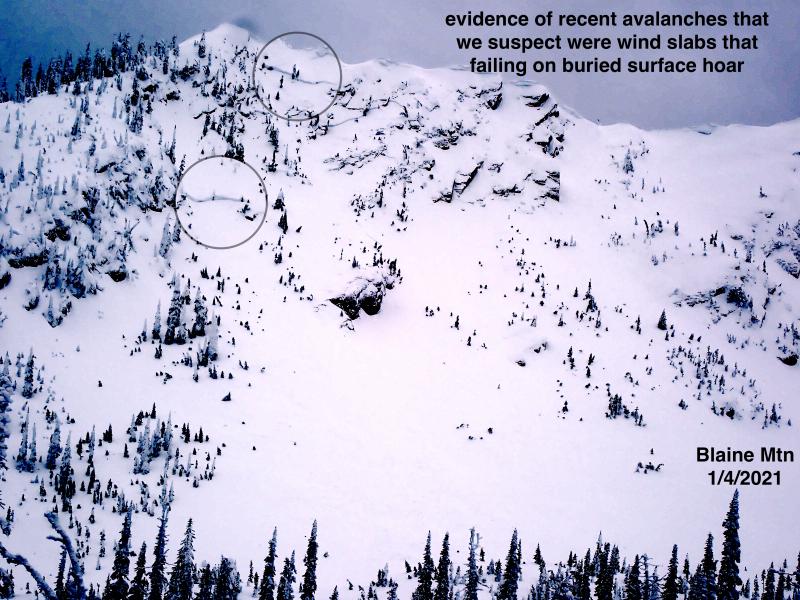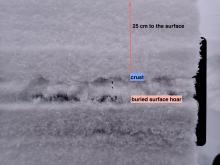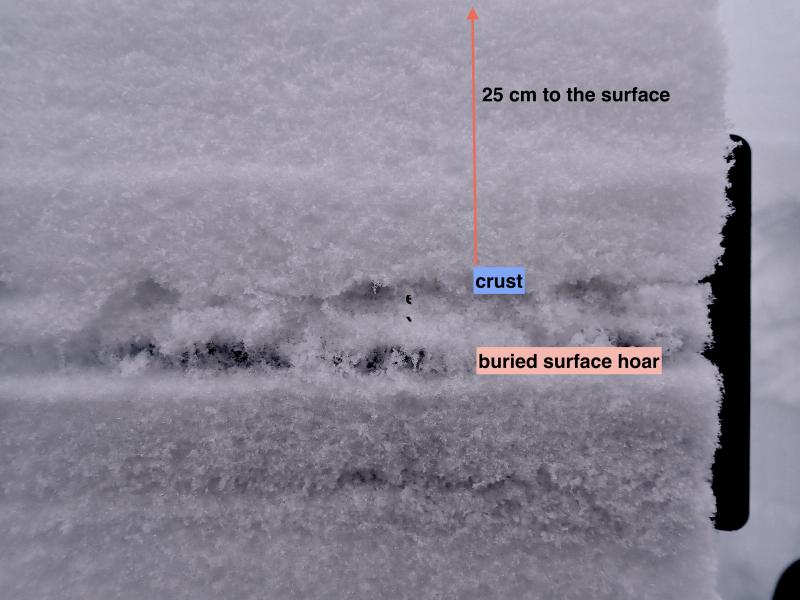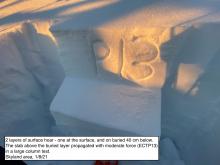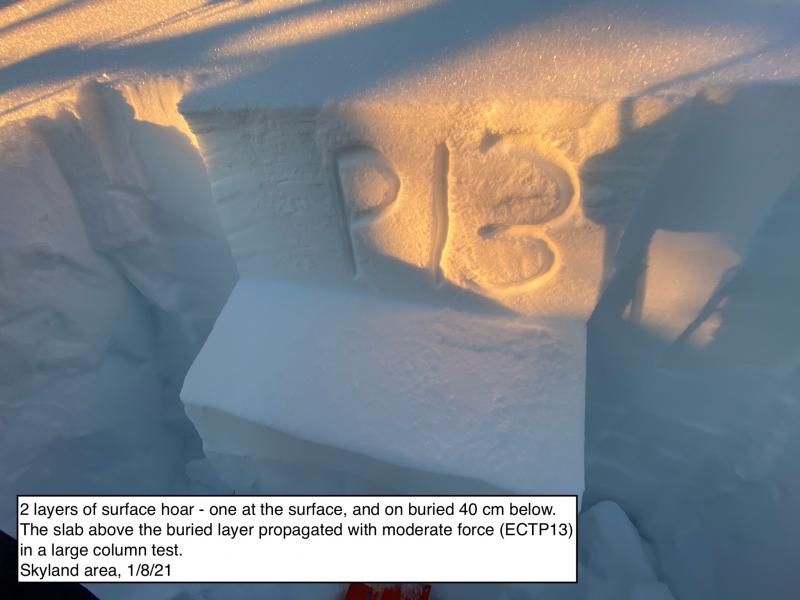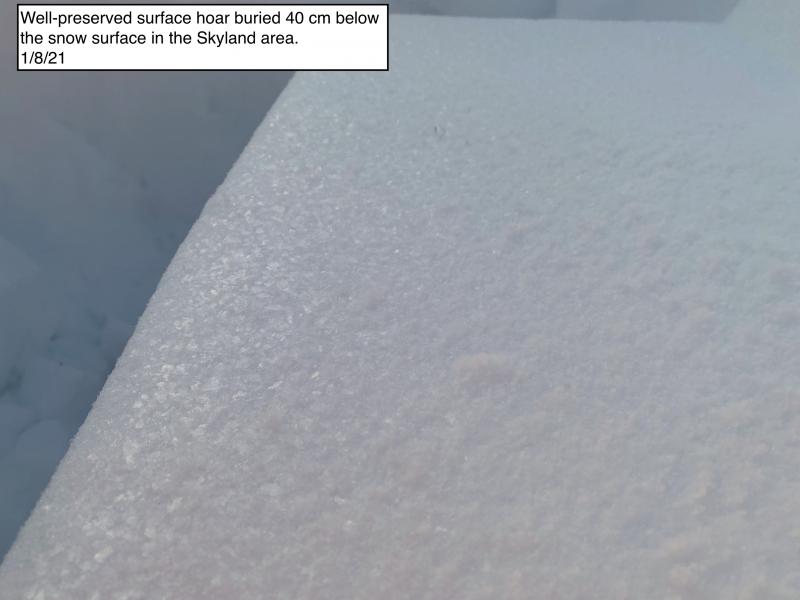| Sunday | Sunday Night | Monday | |
|---|---|---|---|
| Cloud Cover: | Mostly Cloudy | Partly Cloudy | Partly Cloudy |
| Temperatures: | 23 to 29 deg. F. | 15 to 18 deg. F. | 22 to 27 deg. F. |
| Wind Direction: | West | Northwest | Northwest |
| Wind Speed: | 16G32 | 15G29 | 11G22 |
| Snowfall: | 2" to 3" in. | 0" in. | 0" in. |
| Snow Line: | 3000' | 2500' | 1500' |
Flathead Range and Glacier National Park
How to read the forecast
Today's fresh snow is a beautiful sight, but don't forget about what is hidden under the surface. You can still trigger a weak layer buried 1-3 feet below the surface in areas not capped by a thick crust. Anticipate sluffing in the new snow, especially as you gain elevation. Finish your weekend off in style by choosing lower angle planar terrain in areas without a surface crust. Opt for slopes with good runouts free of terrain traps and surface obstacles.

2. Moderate
?
Above 6500 ft.
1. Low
?
5000-6500 ft.
1. Low
?
3500-5000 ft.
- 1. Low
- 2. Moderate
- 3. Considerable
- 4. High
- 5. Extreme
-
Type ?
-
Aspect/Elevation ?

-
Likelihood ?CertainVery LikelyLikelyPossible
 Unlikely
Unlikely -
Size ?HistoricVery LargeLargeSmall

This week's Pineapple Express left a widespread thick, hard crust that ruined the riding and acted as a bridge across our snowpack. The silver lining is that it has diminished our Persistent Slab problem in these areas. Above treeline, the crust is not as widespread, and these are the areas where you can impact buried weak layers. We are monitoring two buried surface hoar layers, one which is about a foot below the surface while the other is 2-3 feet down. Snowpit tests reveal this layer in the pit wall and in propagating results. If you're not interested in digging, sticking to slopes less than 35 degrees that are free of convexities is a wise choice.
Winter-like weather makes a return to the Flathead with several inches of low-density powder, cool temperatures, and breezy conditions. At most low- and mid-elevations, along with isolated upper elevations, snow will fall on crusts or a thin layer of faceted snow capping a crust. Poor bonding may result in triggered sluffs or thin slabs, which, on sustained steep slopes, can run surprisingly long distances due to the slick bed surface. These will be mostly harmless in the Whitefish Range and the Flathead Range, where modest snow totals are forecast. We anticipate higher snow amounts in the Swan Range and have moved storm slab to our number one concern in this range.
Riders are experiencing challenging riding conditions Post Pineapple Express (the other type of PPE). Instead of sticking to your standard mid-season game plan, maybe now is a good time to mix it up. Current conditions are downright hazardous on some slopes, and selecting terrain to minimize the risk of getting injured on the ascent or descent should be weighed. There is value in comparing risk vs. reward in all walks of life, and riding in conditions like ours accentuates that comparison. If you choose the risk, do you have a safety plan to understand what you will do if something goes wrong? Can you self-rescue and self-evacuate? What is in your pack’s first aid kit, and do you know how to use those items? Is your equipment, like many, missing essential items? Can you fabricate a rescue sled out of the gear you are carrying? If not, how will you get someone out of the backcountry who cannot ski or ride? When bad luck strikes and you require rescue, how will you communicate your needs to a rescue organization? Will you be able to keep your partner and/or yourself from becoming hypothermic while awaiting help?
For most of us, these questions sound a bit daunting. Perhaps now is an excellent time to improve a skill set besides our riding skills. FAC staff is required to practice with avalanche beacons once a month. When did you last practice? Do you know there is a beacon park, open to the public, at the top of WMR? Have you assembled your probe and shovel, making sure that everything is in tip-top shape?
When was your last first aid class? If it has been a while, consider what resources you need to refresh your skills. This could be as simple as talking through medical scenarios with a friend, taking an online course, or attending training sessions offered within our community.
While we wait for better conditions, take advantage of this time to work with maps of future trips. The possibilities are endless. The backcountry community thanks you for being better prepared.
A summary of chapter 1 of our season is here
Winter returns for the day with cool temperatures, fresh snow, and breezy conditions. Drier weather is on tap for tomorrow.
This forecast applies only to backcountry areas outside established ski area boundaries. The forecast describes general avalanche conditions and local variations always occur. This forecast expires at midnight on the posted day unless otherwise noted. The information in this forecast is provided by the USDA Forest Service who is solely responsible for its content.




